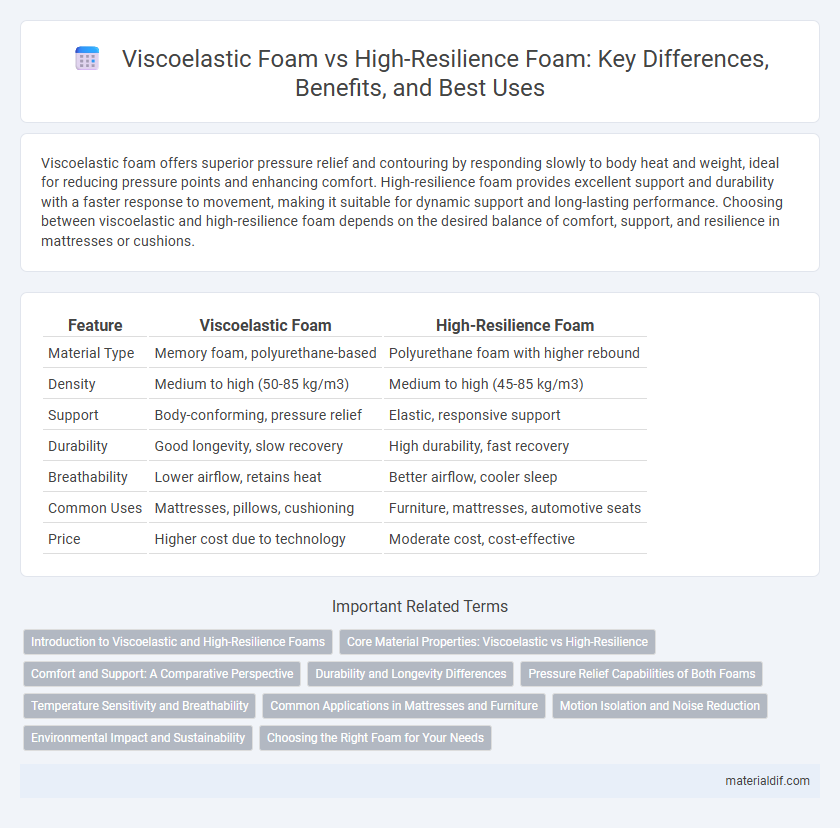Viscoelastic foam offers superior pressure relief and contouring by responding slowly to body heat and weight, ideal for reducing pressure points and enhancing comfort. High-resilience foam provides excellent support and durability with a faster response to movement, making it suitable for dynamic support and long-lasting performance. Choosing between viscoelastic and high-resilience foam depends on the desired balance of comfort, support, and resilience in mattresses or cushions.
Table of Comparison
| Feature | Viscoelastic Foam | High-Resilience Foam |
|---|---|---|
| Material Type | Memory foam, polyurethane-based | Polyurethane foam with higher rebound |
| Density | Medium to high (50-85 kg/m3) | Medium to high (45-85 kg/m3) |
| Support | Body-conforming, pressure relief | Elastic, responsive support |
| Durability | Good longevity, slow recovery | High durability, fast recovery |
| Breathability | Lower airflow, retains heat | Better airflow, cooler sleep |
| Common Uses | Mattresses, pillows, cushioning | Furniture, mattresses, automotive seats |
| Price | Higher cost due to technology | Moderate cost, cost-effective |
Introduction to Viscoelastic and High-Resilience Foams
Viscoelastic foam, often known as memory foam, is characterized by its ability to conform closely to body shape, providing excellent pressure relief and motion isolation due to its slow recovery time. High-resilience foam features a responsive, durable structure with rapid recovery, offering strong support and enhanced airflow for temperature regulation. Both foams are polyurethane-based materials used extensively in mattresses, cushions, and seating, but they differ significantly in density, elasticity, and comfort properties.
Core Material Properties: Viscoelastic vs High-Resilience
Viscoelastic foam features a slow response to pressure and temperature sensitivity, providing superior shock absorption and contouring abilities that enhance comfort and pressure relief. High-resilience foam exhibits rapid response and higher rebound resilience, offering enhanced durability and support with greater breathability. Core material properties of viscoelastic foam prioritize energy absorption and body conformity, whereas high-resilience foam emphasizes structural support and long-lasting performance.
Comfort and Support: A Comparative Perspective
Viscoelastic foam offers superior comfort by contouring closely to the body's shape, easing pressure points through its slow-response memory effect, while high-resilience foam excels in providing support with its quick bounce-back and durable structure that maintains firmness under prolonged use. The viscoelastic foam's density typically ranges between 3 to 6 lbs/ft3, contributing to enhanced pressure relief, whereas high-resilience foam has a density of 1.8 to 2.5 lbs/ft3, ensuring robust support for spinal alignment. Choosing between these foams depends on whether prioritizing pressure distribution and plush comfort or resilience and structural support is essential for personalized sleep ergonomics.
Durability and Longevity Differences
Viscoelastic foam, known for its slow recovery and pressure-relieving properties, typically exhibits moderate durability with a tendency to soften over time, which may reduce its longevity under heavy use. High-resilience foam offers superior durability due to its open-cell structure, enabling faster recovery and consistent support, making it more resistant to sagging and deformation over extended periods. Choosing high-resilience foam enhances longevity in furniture and bedding applications, especially where sustained support and durability are critical.
Pressure Relief Capabilities of Both Foams
Viscoelastic foam offers superior pressure relief by contouring closely to the body's shape, evenly distributing weight and reducing pressure points. High-resilience foam provides good support but does not adapt as precisely, resulting in less targeted pressure alleviation. The viscoelastic foam's slow recovery rate enhances comfort for extended use, making it ideal for users seeking maximum pressure relief.
Temperature Sensitivity and Breathability
Viscoelastic foam demonstrates high temperature sensitivity, softening as it warms to conform closely to body contours, enhancing pressure relief. High-resilience foam maintains its firmness across temperature variations, offering consistent support without softening significantly. Breathability differs as viscoelastic foam typically retains more heat due to its dense structure, while high-resilience foam features an open-cell design that promotes better airflow and cooling.
Common Applications in Mattresses and Furniture
Viscoelastic foam, known for its pressure-relieving properties, is commonly used in mattresses and furniture for enhanced comfort and body contouring. High-resilience foam offers superior support and durability, making it ideal for seating cushions and mattress cores that require long-lasting resilience. Both foams are frequently combined to balance comfort and support in premium bedding and upholstery products.
Motion Isolation and Noise Reduction
Viscoelastic foam excels in motion isolation by absorbing and contouring to body movements, minimizing disturbance between sleepers and significantly reducing noise. High-resilience foam offers moderate motion isolation but responds faster to pressure, which can transfer more motion and generate slight noise when compressed. For superior noise reduction and minimizing partner disturbance, viscoelastic foam remains the preferred choice in mattress applications.
Environmental Impact and Sustainability
Viscoelastic foam, often derived from polyurethane with added chemicals, tends to have a higher environmental impact due to its slower biodegradability and reliance on non-renewable petrochemicals. High-resilience foam, typically produced with fewer additives and designed for durability, offers improved sustainability by enabling longer product life cycles and reducing waste. Both foams can benefit from advances in bio-based raw materials and recycling initiatives to minimize their ecological footprint.
Choosing the Right Foam for Your Needs
Viscoelastic foam, known for its slow response to pressure and excellent contouring properties, is ideal for pressure relief and reducing motion transfer in mattresses and cushions. High-resilience foam offers superior durability and bounce, making it better suited for support structures and applications requiring long-lasting resilience. Choosing the right foam depends on your need for comfort and support versus durability and responsiveness.
Viscoelastic foam vs High-resilience foam Infographic

 materialdif.com
materialdif.com